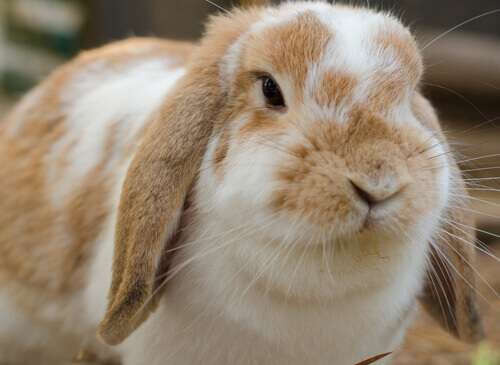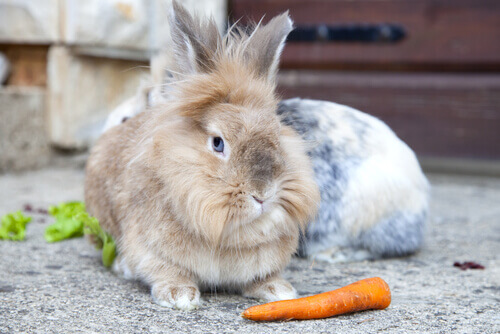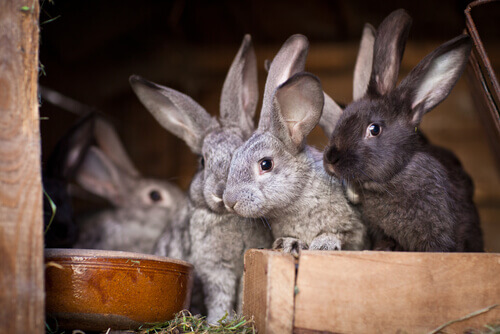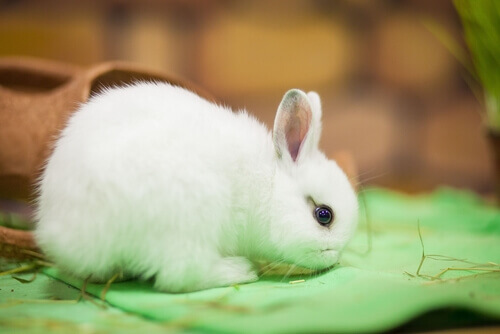How Many Types of Domestic Rabbits Are There?

With their pointy ears and small noses, they’re one of the most gentle pets around. In this article, we’ll tell you how many types of domestic rabbits there are and which are the most popular pets.
Caring for domestic rabbits
Among the more than 50 species of rabbits worldwide, only a few of them are suitable as pets. This means that they’ve been domesticated by man and can adapt to life in an apartment or house. Of course, as long as they receive proper care.
You should keep in mind, for example, that a rabbit’s diet consists of vegetables, herbs, bark, and some fruits. In pet stores, you can also find special rabbit food which gives them all the nutrients they need.
Often, domestic rabbits sleep in cages. However, they can also walk freely in your yard or in your living room. Just be sure to pay attention to them because they can be quite mischievous! Since they have mostly nocturnal habits, they’ll be more active when the sun goes down.
Don’t forget about the hygiene and health of rabbits. In this sense, you should clean its cage every day. Also, your pet will need to eat food that’s rich in fiber in order to “file” its teeth. At the same time, be sure to vaccinate your rabbit, as this will prevent fatal illnesses such as myxomatosis and hemorrhagic disease.
Types of domestic rabbits
Among the different types of domestic rabbits, we want to highlight the following, as they’re the most popular:
1. The Holland lop
The Holland lop, which appears in our title image, was created in 1950 in Holland after ‘combining’ the qualities of the French lop and the Dutch dwarf. Its main characteristic is that it has droopy ears. It also has a compact body, is small, and lies on its front legs like cats.
The coat of this rabbit is quite dense and of medium length. Therefore, it requires a lot of care (weekly brushing for example). The coat can consist of one or two colors, or have white, gray, orange, or beige spots.
2. The lionhead rabbit
As its name indicates, this rabbit has a kind of ‘mane’ on its head, which is actually longer and more puffy than the rest of the body. It came about through the crossing of two breeds: The Belgian dwarf and the Swiss fox. It’s also related to the dwarf rabbits.

This particular rabbit can weigh up to 4.5 pounds and their ears can measure up to 2.75 inches long. What’s more, its legs are stronger and thicker than those of other types of domestic rabbits. As for its temperament, it’s calm and affectionate, ideal for homes with children. It requires periodic combing, some exercise, and adequate food.
3. The rex rabbit
Large pointed ears, a robust body, intelligence, and ‘maternal’ behavior could be the main characteristics of the rex rabbit. Its soft coat, as soft as chamois, is the product of a genetic mutation of the breed.

The rex is of French origin, although it’s now more common in England. It’s a large rabbit, weighing about 9 pounds, and has curly whiskers. Its coat can vary between different colors: white, gray, brindle, orange, brown, black. The pattern of its body is variable.
4. The Netherland dwarf rabbit
Thanks to its name you can guess two of its main characteristics. That is, it comes from the Netherlands and is rather small. Its coat can come in different colors (gray, black, orange, brown) and its ears are short. What’s more, it has a well-proportioned and round body, as if it were a ball.

The Dutch dwarf weighs about 2.2 pounds and, believe it or not, it eats quite a lot! If you have one, you’ll have to feed it fruits, vegetables, green fodder, and specific food. As for daily care, don’t forget to brush your rabbit and take it outdoors to get some sun.
All cited sources were thoroughly reviewed by our team to ensure their quality, reliability, currency, and validity. The bibliography of this article was considered reliable and of academic or scientific accuracy.
- Van den Broeck, W., Mortier, P., & Simoens, P. (2001). Scanning electron microscopic study of different hair types in various breeds of rabbits. Folia Morphologica, 60(1), 33-40.
- Apori, S. O., Osei, D., & Hagan, J. K. (2014). The growth and reproductive performance of different breeds of rabbits kept under warm and humid environments in Ghana.
- Nasr, M. A., Abd-Elhamid, T., & Hussein, M. A. (2017). Growth performance, carcass characteristics, meat quality and muscle amino-acid profile of different rabbits breeds and their crosses. Meat science, 134, 150-157.